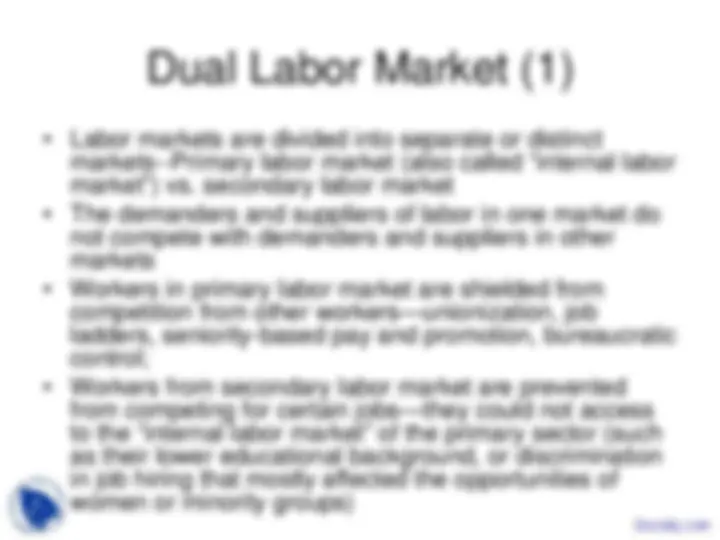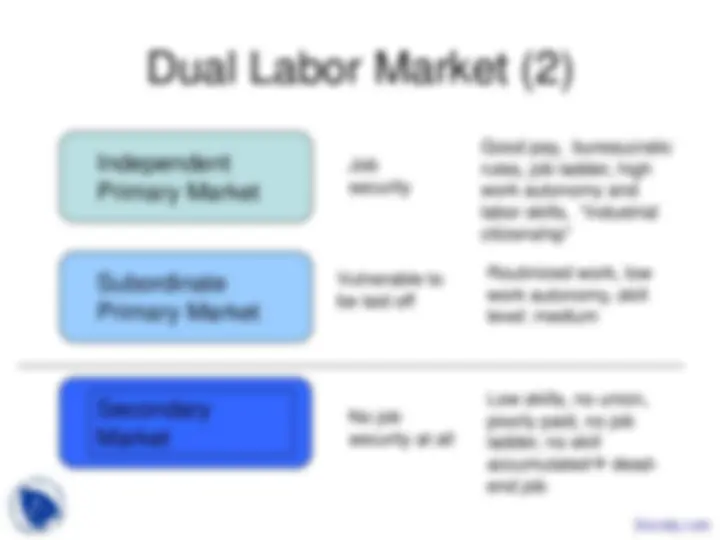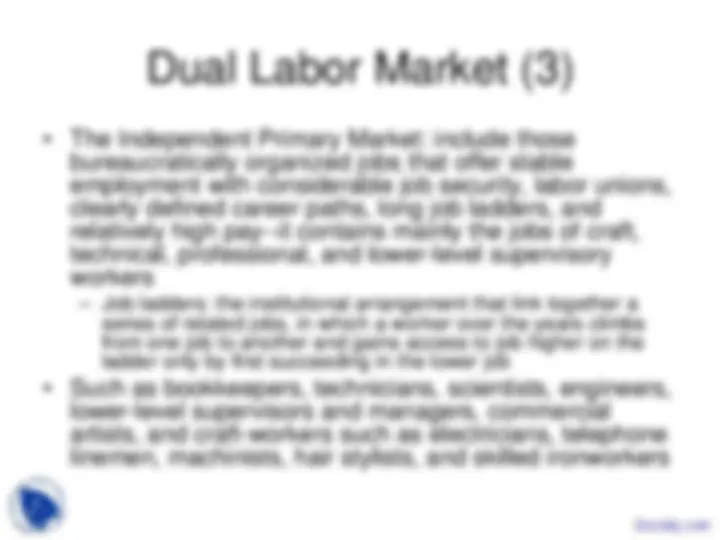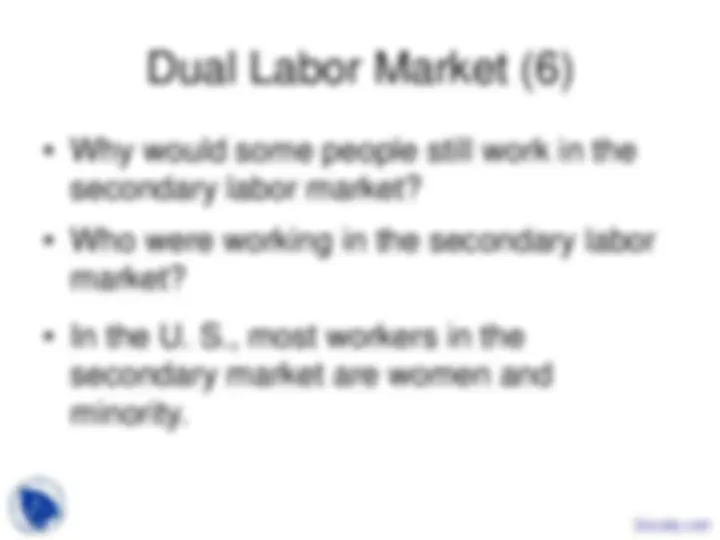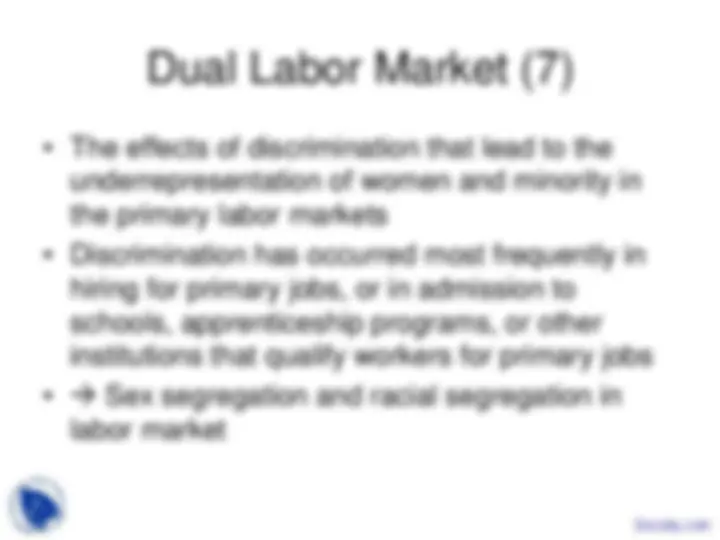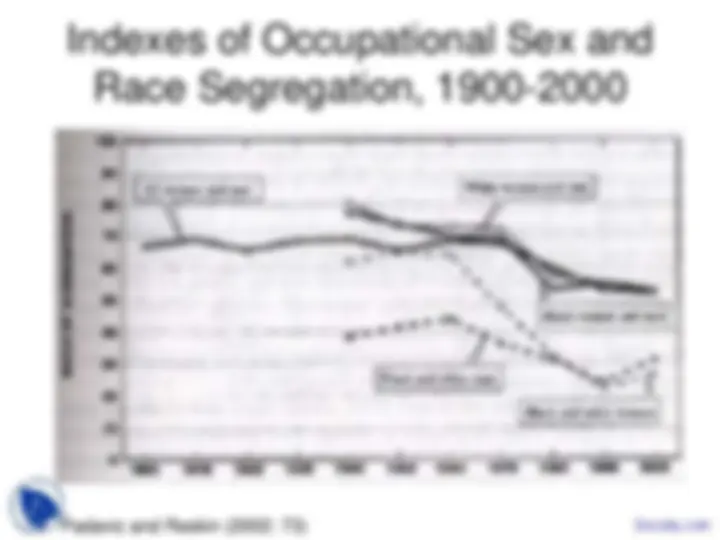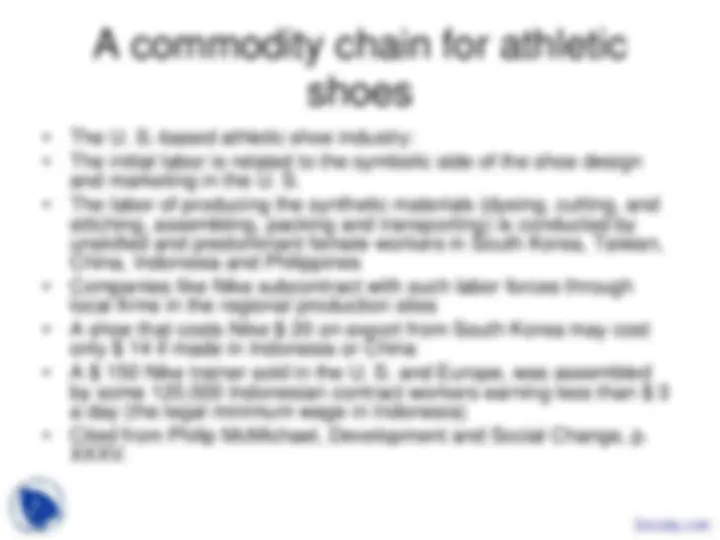Download Understanding Dual Labor Market System's Impact on Workers and more Slides Economic Sociology in PDF only on Docsity!
Segmented Labor Market
Major Issues
- Topic 4: Segmented Labor Market in a Nation: “Dual Labor Market” (Samuel Bowles and Richard Edwards’ research on 20 th. Century U. S. economy)
- Sexual and racial/ethnic segregated labor market
- Topic 5: discussion of labor market will be extended in the framework of global economy—International division of labor
- Theories of international division of labor: dependency theory and the world-system paradigm
- The International Division of Labor from W. W. II to the late 1970s., the New International Division of Labor from the 1980s (esp. economic ties between Taiwan and Hong Kong of the “four tigers” and the emerging economy of mainland China)
Dual Labor Market (2)
Independent
Primary Market
Secondary
Market
Subordinate
Primary Market
Job security
Vulnerable to be laid off
No job security at all
Good pay, bureaucratic rules, job ladder, high work autonomy and labor skills, “industrial citizenship”
Routinized work, low work autonomy, skill level: medium
Low skills, no union, poorly paid, no job ladder, no skill accumulated dead- end job
Dual Labor Market (3)
- The Independent Primary Market: include those bureaucratically organized jobs that offer stable employment with considerable job security, labor unions, clearly defined career paths, long job ladders, and relatively high pay--it contains mainly the jobs of craft, technical, professional, and lower-level supervisory workers - Job ladders: the institutional arrangement that link together a series of related jobs, in which a worker over the years climbs from one job to another and gains access to job higher on the ladder only by first succeeding in the lower job
- Such as bookkeepers, technicians, scientists, engineers, lower-level supervisors and managers, commercial artists, and craft-workers such as electricians, telephone linemen, machinists, hair stylists, and skilled ironworkers
Dual Labor Market (5)
- The Secondary Market: most remaining workers from the former two sectors
- They are highly diverse, unified only in that it is the preserve of workers who have few protections from worker rights and elaborate employer-imposed ways of organizing work
- Blue-collar workers in nonunion factories; non-union janitors, waitress, guards, retail sales clerks, typists, file clerks, and recordkeepers; seasonal or migrant farm workers; and most employees of small businesses
- Despotic control, no job security, no unionization, no job ladder, be poorly paid. Neither schooling nor seniority is rewarded
Dual Labor Market (6)
• Why would some people still work in the
secondary labor market?
• In the U. S., most workers in the
secondary market are women and
minority.
• Who were working in the secondary labor
market?
Indexes of Occupational Sex and
Race Segregation, 1900-
Padavic and Reskin (2002: 73) Docsity.com
Occupational-level Sex
Segregation (Top 10 occupations for men
and women in the U. S. today)
- Secretaries
- Cashiers
- Registered nurses
- Elementary school teachers
- Nursing aides
- Bookkeepers, accounting and auditing clerks
- Waitress
- receptionists
- Supervisors and proprietors, sales occupations
- Truck drivers
- Janitors and cleaners
- Carpenters
- Cooks
- Computer systems and analysts and scientist
- Labor
- supervisors, production occupations.
1 Managers and administrators 2
- Supervisors and proprietors, sales occupation 4.
Based on Padavic and Reskin (2002: 60)
A commodity chain for athletic
shoes
- The U. S.-based athletic shoe industry:
- The initial labor is related to the symbolic side of the shoe design and marketing in the U. S.
- The labor of producing the synthetic materials (dyeing, cutting, and stitching, assembling, packing and transporting) is conducted by unskilled and predominant female workers in South Korea, Taiwan, China, Indonesia and Philippines
- Companies like Nike subcontract with such labor forces through local firms in the regional production sites
- A shoe that costs Nike $ 20 on export from South Korea may cost only $ 14 if made in Indonesia or China
- A $ 150 Nike trainer sold in the U. S. and Europe, was assembled by some 120,000 Indonesian contract workers earning less than $ 3 a day (the legal minimum wage in Indonesia)
- Cited from Philip McMichael, Development and Social Change, p. XXXV.

